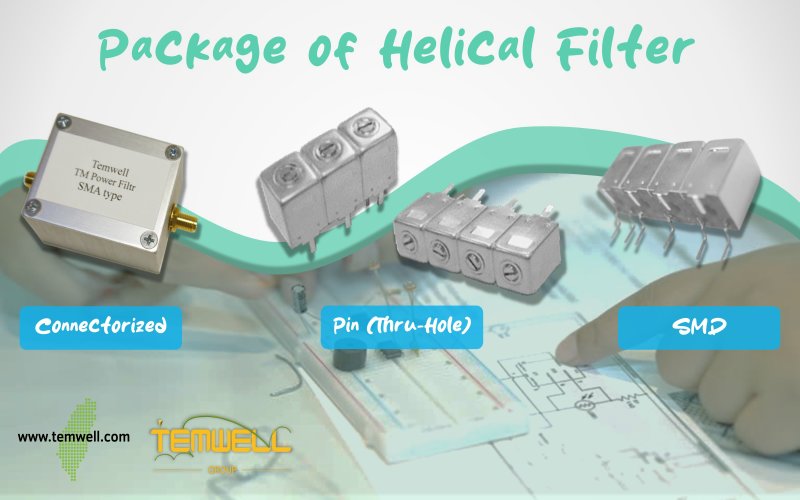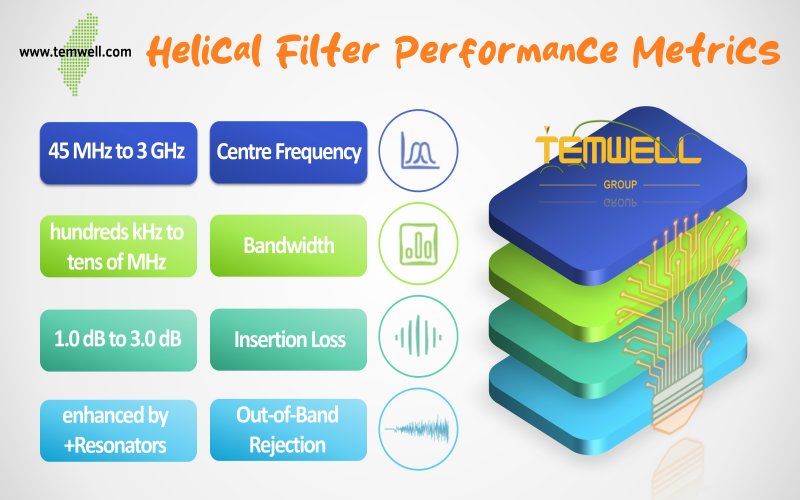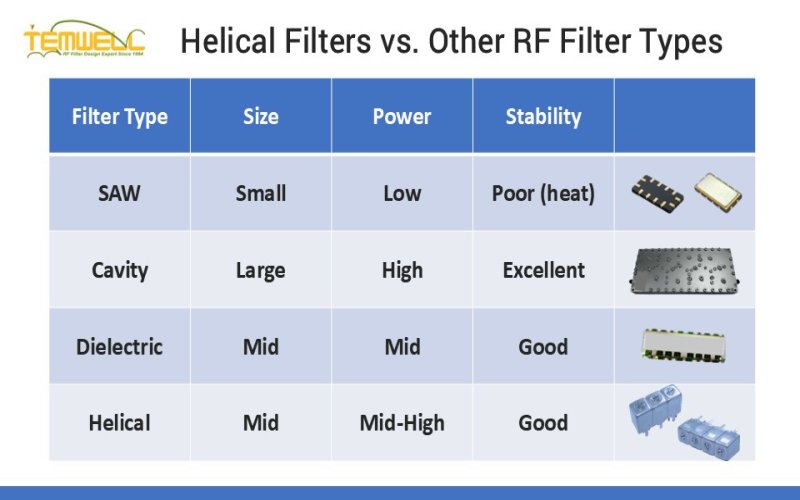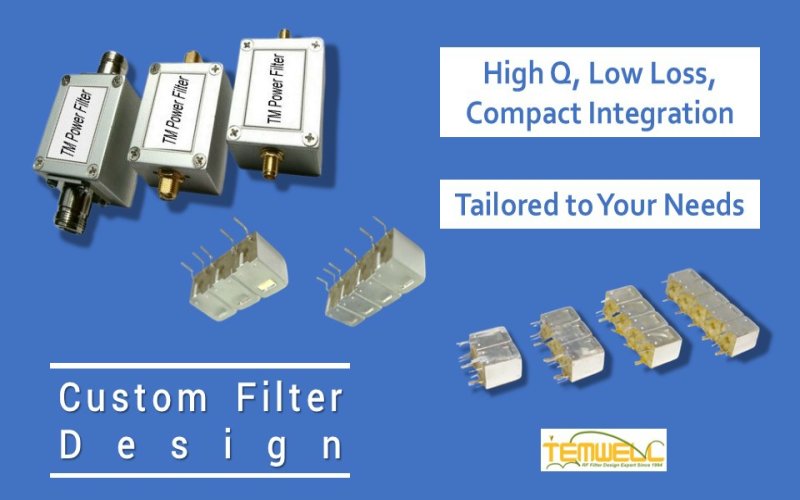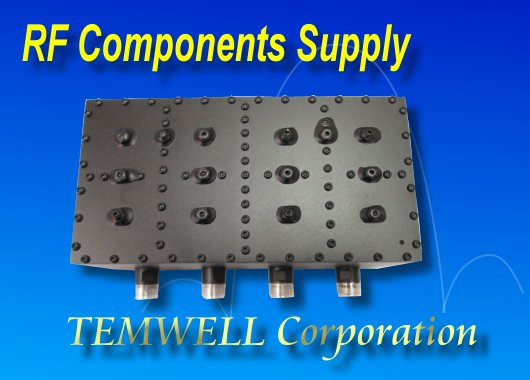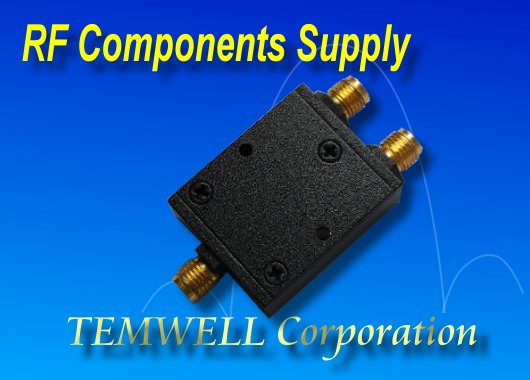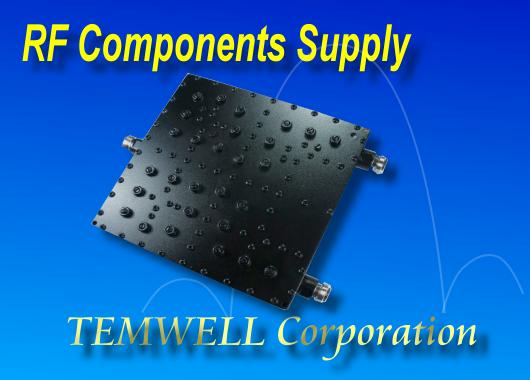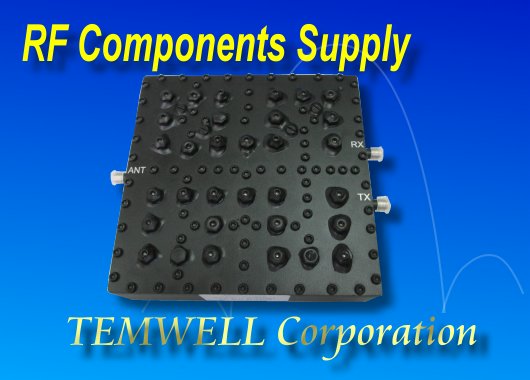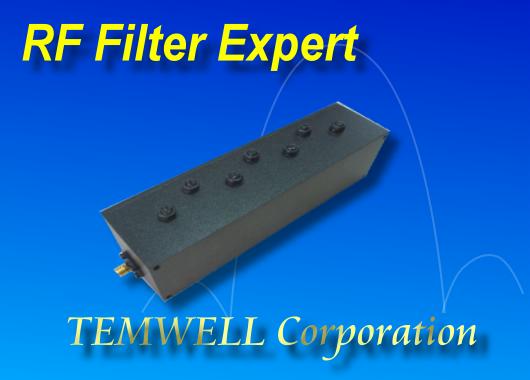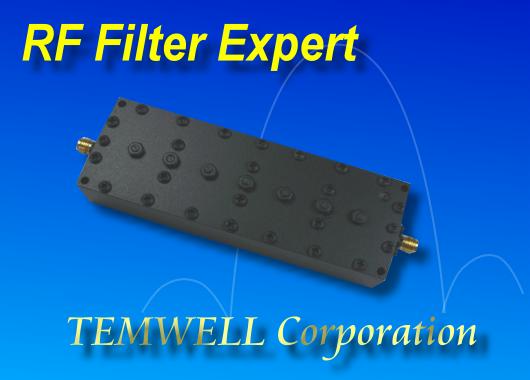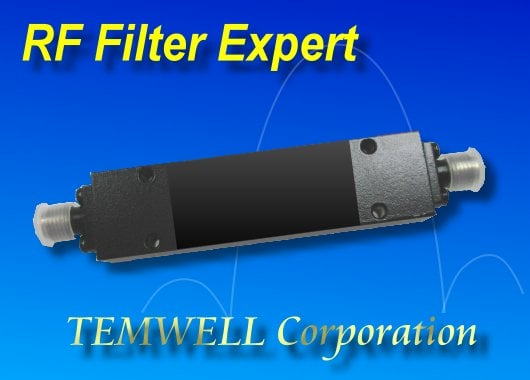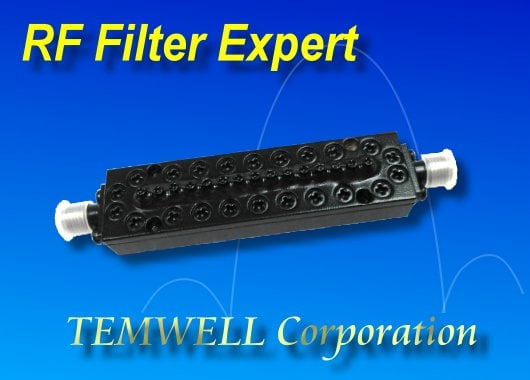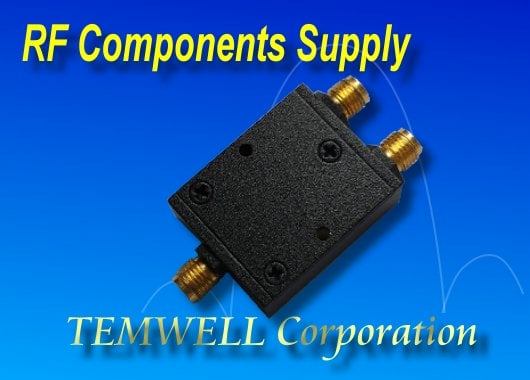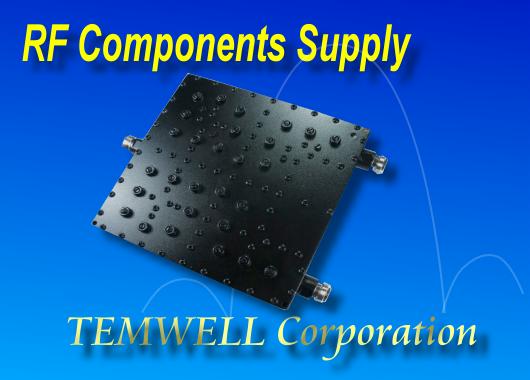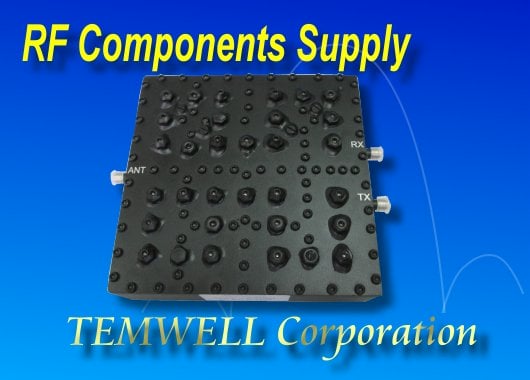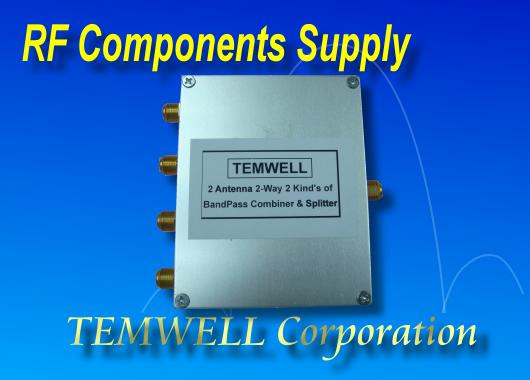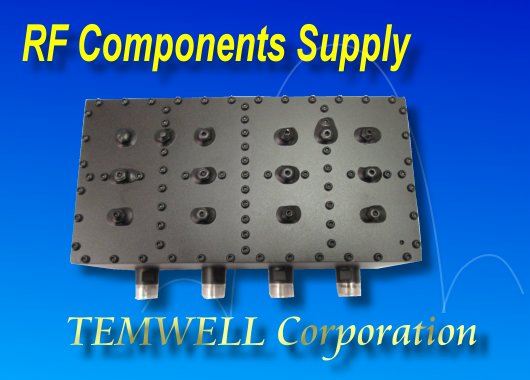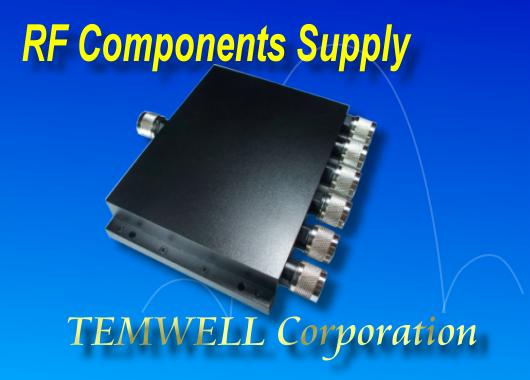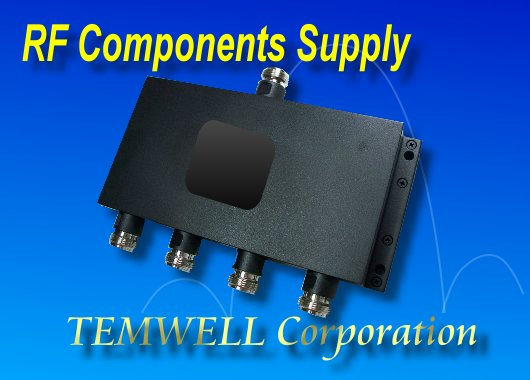What is a Helical Filter?

What is a Helical Filter?
Helical Filter is an RF filter that uses a spiral coil and a metal cavity to form a resonant structure. It has a high Q value, low insertion loss and good frequency stability, and is a resonant filter. The basic principle is to wind the conductor into a spiral shape to form a resonant structure of inductance and distributed capacitance, thereby achieving a bandpass or bandstop filtering effect in a specific frequency band.
Its main function is to selectively allow specific frequency signals to pass through and suppress unnecessary interference frequency bands. Because its structure can effectively extend the signal propagation path, provide high Q value and good selectivity, it is particularly suitable for application in VHF (30-300MHz) and UHF (300-3000MHz) frequency bands.
Common applications of Helical Filters include radio transceiver systems, radars, television broadcasting, military communications, and various wireless modules. Its advantages are relatively compact size, high design flexibility, good frequency stability, and the ability to achieve frequency fine-tuning through simple mechanical adjustment methods. Therefore, it has become a commonly used filter type in RF teaching and experiments.
In terms of style, Helical Filters are commonly packaged in metal shielding boxes, with SMA-type, N-type and other connector outputs. Through hole PIN or SMD packages are also available, making it easy to match different applications and testing requirements. For RF engineers and students, Helical Filter is an ideal component for both theory and practice, suitable for purposes such as frequency selectivity, noise suppression and signal shaping.
Features of Helical Filter
Helical Filter has the following characteristics due to its unique structure and excellent performance:
1. Small size, suitable for space-constrained applications
Helical Filter uses a resonant structure consisting of a spiral coil and a metal cavity to significantly reduce the size while maintaining a high Q value. Compared with traditional cavity filters, its size is more compact and is particularly suitable for space-constrained application scenarios such as handheld devices, vehicle-mounted modules and portable communication devices. In addition, this structure also helps to reduce manufacturing costs and weight, and improve the portability and flexibility of the overall system.
2. High design flexibility and adjustable performance parameters
The design of the Helical Filter is highly flexible and can quickly achieve different center frequency and bandwidth requirements by adjusting the size, number of turns, spacing and cavity geometry of the spiral coil. This adjustability enables it to meet a variety of customized filtering requirements and enable rapid prototyping and performance verification in the early stages of the design. In addition, by increasing the number of resonators, the selectivity and suppression capability of the filter can be further improved to meet higher performance application requirements.
3. Support mechanical adjustment to achieve parameter matching
Helical Filters are usually equipped with a mechanical tuning structure, such as a tuning screw, which allows the user to fine-tune the frequency after installation. This mechanical adjustment method enables the filter to real-time modify performance optimizely in response to environmental changes or system requirements in actual applications, thereby improving the stability and reliability of the overall system. This feature is particularly important when on-site adjustment or batch production is required.
4. Diverse output types, easy for system integration
In order to meet different application requirements, Helical Filter provides a variety of output interface options, including SMA-type, N and other coaxial connectors, as well as through hole PIN or SMD packaging. This diverse output type design allows it to be easily integrated into various circuit board designs and system architectures, improving design flexibility and convenience. Whether it is used in high-frequency modules, RF front-ends or other communication equipment, Helical Filter can provide stable and efficient filtering solutions.
In summary, Helical Filter is a good choice for RF engineers and students in the design and learning process due to its small size, high design flexibility, mechanical adjustment, and support for multiple output types. It strikes a good balance between performance and practicality and is suitable for various medium-frequency and high-frequency RF application scenarios.
Main parameters of Helical Filter
1. Center Frequency
The center frequency of Helical Filters is typically in the range of 45 MHz to 3 GHz, and is particularly suitable for use in the VHF to UHF frequency bands. Its resonant frequency is mainly determined by the physical size of the spiral coil and the cavity structure. By adjusting the length, diameter, number of turns of the spiral coil and the size of the cavity, the desired center frequency can be precisely set. In addition, Helical Filter supports mechanical tuning structure, using tuning screws, allowing users to fine-tune the frequency after installation to meet the changing needs in actual applications.
2. Bandwidth
The bandwidth of the Helical Filter depends on its design structure and application requirements. Typically, their -3 dB bandwidth can range from hundreds of kHz to tens of MHz. By increasing the number of resonators or adjusting the coupling method, narrower or wider bandwidths can be achieved to meet different filtering requirements.
3. Insertion Loss
Insertion loss is an important value to measure the degree of enegry reduction within the passband. Helical filters typically have low insertion loss, with typical values between 1.0 dB and 2.0 dB. This makes it an excellent choice for RF systems that require high performance, especially in the receive front end, where low insertion loss helps maintain the overall gain and signal-to-noise ratio of the system.
4. Out-of-Band Rejection
Out-of-band rejection is a measure of the filter's ability to attenuate unwanted signals outside the passband. Helical Filter usually has good out-of-band suppression performance and can effectively suppress interference signals of adjacent frequencies. In addition, the out-of-band suppression performance of the Helical Filter can be further improved by increasing the number of resonant structures of the spiral coil (i.e. increasing the number of resonator stages). Using multiple resonators can achieve steeper curve edges and higher rejection levels, meeting the needs of high-performance requirement.
Comparison with other RF filters
Helical Bandpass Filter is a commonly used filter in the medium to high frequency range in the RF and communication fields. It has high Q value, low insertion loss and good frequency stability. Its structure consists of a spiral conductor and a metal cavity. It is medium in size and suitable for using SMA-type or N-type connectors. It can also be designed as a through hole PIN or SMD package. It is highly flexible and easy to integrate in modular or system design.
Compared to other common filter types, Helical Filter strikes a good balance between performance and volume. SAW (surface acoustic wave) filters are extremely small and can be packaged at the SMD level, making them ideal for high-frequency and space-constrained consumer electronic devices such as mobile phones, Wi-Fi, and Bluetooth. However, SAW filters have limited power handling capabilities and poor stability under high temperatures and harsh environments.
Cavity filters are known for their extremely high Q value and excellent sideband suppression capabilities, and are commonly found in base stations, radar systems, and satellite communications. It is large and heavy, but can handle high-power signals and is suitable for use in critical communication systems that require high performance. The dielectric resonator (DR) filter achieves a compromise between size and performance, providing good thermal stability and high-frequency operation capabilities. It is often used in medium and high-frequency wireless systems, 5G base stations and microwave modules.
In general, if you need to achieve high Q value and adjustability in the mid-frequency band while taking into account size and cost, Helical Filter is an ideal choice. If you are looking for ultra-miniaturization, SAW filters are the best solution; if you need to handle high power, you should choose cavity filters; if you value thermal stability and mid-to-high frequency performance, dielectric resonant filters would be a better solution. Choosing the appropriate filter type according to different application requirements can help improve the overall RF system performance and stability.
Common applications
Helical Filters are widely used in a variety of radio frequency (RF) and communication products, with a frequency range of approximately 45 MHz to 3 GHz. The main application areas are as follows:
1.Wireless communication equipment
Helical Filters are commonly used in various wireless communication systems, such as trucks, trains, marine and aviation communication equipment. Its high selectivity and low loss characteristics help improve receiver sensitivity and reduce interference. In addition, for applications requiring high power handling capabilities, such as terrestrial UHF mobile communication systems, Helical Filters offer a more compact alternative to traditional coaxial cavity filters.
2 Broadcasting and cable television equipment
In television and cable TV systems, Helical Filters are used to selectively pass desired frequencies and suppress unwanted signals to ensure signal clarity and stability. Its high Q and good out-of-band rejection make it an ideal choice for these applications.
3 Network communication equipment
Helical Filter is suitable for indoor transmitting and receiving equipment, intercom and other network communication equipment. Its adjustable center frequency and diverse output interfaces (such as SMA, N-type, PIN or SMD packages) make it easy to integrate into various circuit board designs and system architectures, enhancing design flexibility and convenience.
4 Disaster prevention and relief communication equipment
In disaster prevention and rescue communication equipment such as firefighting and emergency broadcasting, Helical Filter provides stable and efficient suppression filtering solutions. Its high selectivity and high rejection characteristics help ensure the reliability and clarity of critical communications.
5. Test and experimental equipment
In the experimental equipment of the Laboratory Development and Test Center, Helical Filters are used to accurately select the required frequencies and suppress unwanted signals. Its adjustable center frequency and high Q value make it an ideal choice for testing and experimental applications.
6. Ham Radio Applications
In the field of amateur radio (Ham Radio), helical filters are particularly suitable for filter design in the VHF (very high frequency) and UHF (ultra-high frequency) bands, especially in the 2 meter (144–148 MHz) and 70 cm (430–450 MHz) bands. The diverse Helical Filter standard product series provides amateur radio users with abundant choices to meet different frequency band and performance requirements. In addition, for users who do white space design, Helical Filter is also widely loved for its flexibility and versatility.
7 Military and aerospace applications
Helical Filters are suitable for military and aerospace applications such as satellite communications, radar, and signal intelligence (SIGINT) due to their high reliability and electrical performance. Its compact structure and light weight make it particularly suitable for applications with limited space and strict performance requirements.
Customization Service from Temwell
Temwell Group is a professional RF filter manufacturer in Taiwan with over 30 years of design and manufacturing experience, focusing on providing high-quality Helical Bandpass Filter customization services. Our customization capabilities cover multiple parameters including center frequency, bandwidth, impedance, size, attenuation value, and connector type, which can meet various application requirements from 42 MHz to 2600 MHz.
Service features include:
1. Fast delivery: Customized products can be designed and manufactured within 14 working days.
2. Low MOQ request: The minimum order quantity for each new design product is only 10 pieces, which is suitable for small batch needs.
3. High-performance design: By increasing the number of resonators, the out-of-band suppression can be improved by about 10 dB per stage, up to 90 dB, which is suitable for applications with high selectivity requirements.
4. Flexible connector selection: Provides a variety of connector options such as SMA/N-type connector, through hole PIN, SMD package, etc., which is easy to integrate into different systems.
5. Provide alternative solutions to Toko series filters: satisfy customer demand for standard Toko Helical products.
Temwell's products are widely used in wireless communications, broadcasting, cable TV, disaster prevention and relief communications, laboratory testing, radar, drones, AIoT module design and other fields. All products are all manufactured in Taiwan, comply with RoHS and REACH standards, and are ISO9001 certified, the quality is guaranteed.
If you have specific filter requirements, please feel free to contact us and get free consultation services so that we can provide you with the best solution.
Subscribe to us on Facebook for the latest product news.



